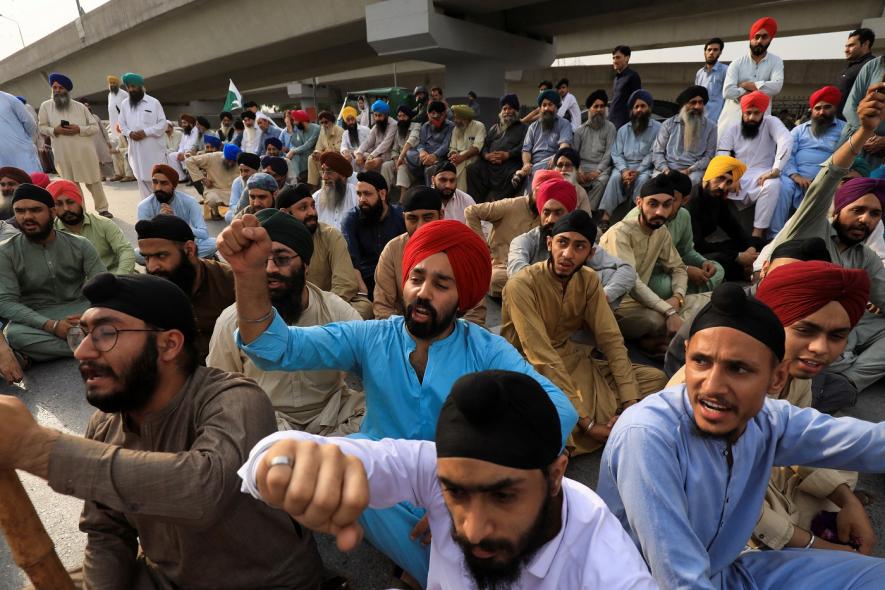Do the Sangh and Prime Minister Narendra Modi Love the Sikh Community?

Image for representational purpose. Credit: Tribune India
These days, Prime Minister Narendra Modi and his government are busy projecting themselves as great sympathisers of the Sikh community. The last significant event to promote this image was on 21 April, the 400th birth anniversary of the ninth Guru of Sikhs, Guru Tegh Bahadur, when Modi addressed a special program organised at the Red Fort and issued a commemorative coin and stamp. This program was organised jointly by the central government and the Delhi Gurdwara Management Committee.
Similarly, on 29 April, the Prime Minister met a Sikh delegation of mostly overseas Indian Sikhs at his residence. Modi told this delegation, “Without the contribution of the Sikh community, the history of India would not be complete and neither would India be complete. The Sikh tradition is the best example of ‘Ek Bharat, Shreshtha Bharat’.” In his 15-minute speech, the Prime Minister called the overseas Indian Sikhs “India’s national ambassadors”. He claimed personal affinity with the Sikh fraternity and said visiting gurdwaras, langars (community dining) and living with Sikh families are a natural part of his life.
While the media played up this news, many Sikh scholars saw Modi’s “Sikh love” as cause for suspicion. It also reminded many of the old anti-Sikh nature of the Prime Minister’s Bharatiya Janata Party (BJP) and its parent, the Rashtriya Swayamsevak Sangh (RSS).
Noted Sikh thinker and senior journalist Jaspal Singh Sidhu says, “The main reason for the Modi government to celebrate the 400th birth anniversary of Guru Tegh Bahadur Ji at the Red Fort in Delhi is to strengthen the anti-Muslim narrative under the BJP rule. It was from the Red Fort that Mughal ruler Aurangzeb had ordered the martyrdom of Guru Tegh Bahadur. The Modi government is doing this to make the Sikhs, a minority community, stand in opposition to the Muslim community.
“However, the Sikhs who met Modi at his residence have no special place within Sikh society. On the day Guru Tegh Bahadur Ji’s anniversary was celebrated at the Red Fort, some BJP-minded turbaned youth stood holding placards that said, ‘Aurangzeb martyred our Guru, but why are cities named after Aurangzeb and his descendants in the country?’” This view advocates the saffron party’s idea of changing localities named after Muslims.
Prof. Bawa Singh, former deputy chairman of the National Commission for Minorities, has a deep understanding of Sikh politics. He says, “The RSS and BJP have anti-minority beliefs. While they consider Islam their main enemy, they also want to ideologically eliminate Sikhism. Therefore, sometimes, they describe Sikhism as a part of the Hindu religion, and sometimes they present the sacrifices and battles for humanity the Sikh gurus fought as anti-Muslim fights. In fact, it is the proximity of the Sikhs and Muslims that is troubling the Hindutva government, because it is only from Punjab that the voices of Kashmiris were raised on a large scale.” He points out that even when the Citizenship Amendment Act was passed in 2019, the Sikh brotherhood stood with the Muslims. The Punjabis and Sikhs abroad also oppose Modi during his overseas visits. The BJP and the Sangh [RSS outfits] are also trying to tighten their grip on Sikh religious institutions. The prime minister wants to include the Sikh brotherhood in his anti-Hindu and anti-Muslim agenda. “The Sangh government has created a small group of Sikhs who spread hate and propaganda against the Muslims. Though this group with Sangh mindset is still very weak, every Sikh who believes in what the gurus said must beware of them,” he says.
Remember that even before the Punjab Legislative Assembly election, the BJP had inducted many Sikh “faces”. Most were from the Akali Dal or panthik background. These include Manjinder Singh Sirsa, former president of the Delhi Gurdwara Committee (who contested and won the Assembly election on the BJP symbol during the BJP-Akali Dal alliance), and Damdami Taksal leader Prof. Sarchand Singh and others. For the last few years, the BJP has started inducting Sikh faces (especially Jatt Sikhs) into the party to strengthen its base in rural Punjab.
Around two years ago, the BJP government promised action on many Sikh issues, such as removing overseas Sikhs from a “blacklist”, justice for the 1984 massacre victims and the release of Sikh prisoners who have completed their sentences, but these issues are pending as before. Prof. Bawa Singh says, “In the program held at Red Fort on 21 April and while addressing Sikh delegates at his residence on 29 April, Modi added so-called nationalism and a saffron tinge to his speech. In his speeches, he used words like ‘Maa Bharati’ and ‘Ek Bharat Shreshtha Bharat’. The sacrifices Guru Tegh Bahadur Ji made for humanity were presented as sacrifices for the Indian nation when the modern concept of an Indian nation had not come into existence. In their speeches at different places on this day, other BJP leaders also limited the wonderful sacrifice of Guru Tegh Bahadur Ji to one for ‘saving Hinduism’.” Similarly, he says, in his 29 April speech, Modi connected the Sikh tradition with his ‘Ek Bharat Shreshtha Bharat—One India Strong India’ thinking. “Surprisingly, nobody in the delegation questioned Modi for saying these things,” says Bawa Singh.
According to Gurpreet Singh, a Punjabi-origin journalist living in Canada, the Modi government wants to build its credibility among migrant Sikhs by showing a false affinity. “This is because they live in every corner of the world, have status in their countries, and with their help, the Modi government wants to project a liberal image of itself to the world,” he says. According to him, some overseas Sikhs consider themselves community leaders. Their voices match what the Indian Embassy and the current government of India believe. “These so-called Sikh leaders have their own interests. For example, when Indian journalist Rana Ayyub visited Canada in 2017, she was not allowed to speak at the historical Gurdwara in Surrey due to pressure from Indian authorities, who argued her speech would threaten mutual brotherhood and goodwill. Whereas Narendra Modi was warmly welcomed in this gurudwara in 2015,” he says.
“There are many examples of the anti-Sikh past of the BJP and the Sangh, whether it is the role of the ‘Punjabi Suba’ movement, whether it is a matter of supporting the organisations that demand the opening of tobacco, beedi, and gutka shops near the Darbar Sahib in Amritsar,” says Gurpreet. “Or the matter of Harbans Lal Khanna, the state-level BJP leader who broke the Darbar Saheb model, the RSS and BJP pressurising the government to conduct Operation Blue Star or the role of the BJP and the Sangh in the 1984 Sikh massacre,” says he.
The question, according to him, is whether the Prime Minister, who calls himself a true sympathiser of the Sikhs, can live up to his claims. For example, in Gujarat, his government introduced a bill to snatch away the lands of Sikh farmers settled in the Kutch and Bhuj regions for years. When the law got defeated in the High Court, the Modi-led state government took the matter to the Supreme Court. Surendra Singh Bhullar, a leader of Punjabi farmers who settled in Gujarat, says, “Now the local BJP leaders are doing hooliganism with us to push us out of here. In fact, Modi is not only against the Muslims but against all minorities.” Bhullar explains further that most Gujarati Sikhs had voted for the BJP, hoping Modi would raise their concerns, but he “showed us his real views when he blamed us”.
There are around 20,000 Sikh votes in Bhullar’s area. “When we took our concerns to Modi during the 2012 Gujarat Assembly election, he told us he does not need our votes and if we have problems then we can stop farming. At that time, the BJP candidate did not even come to seek votes from Sikhs,” says Bhullar.
Besides, many remember how Modi, as Chief Minister of Gujarat, insulted the Sikh community on the pretext of a jibe against the first Sikh Prime Minister, Dr Manmohan Singh. Modi once called Manmohan Singh “Shikhandi” and once made a crude reference to ‘twelve o’clock’ while talking about him. This barb drew strong opposition from the Sikh community. The present Modi government still uses the phrase Sikh terrorism in official documents. According to a report published in The Caravan magazine in May 2019, the “Standing Focus Group of Terror Financing” aims to “work on Islamic and Sikh terrorism”. In one article, “Moment of Soul Searching”, Nanaji Deshmukh, awarded the Bharat Ratna by the Modi government, praises Indira Gandhi for the military action taken at the Darbar Sahib and justifies the 1984 Sikh massacre by calling it a result of the mistakes of Sikh leaders. Many BJP leaders have publicly made controversial statements about Sikhs. About three years ago, Haryana government minister Anil Vij had also abused the community. During the farmer movement, the BJP, Sangh leaders, pro-Modi personalities, including ministers in government, and pro-government media defamed Sikh farmers by calling them Khalistani and other derogatory remarks. Modi never questioned this.
In January, the people of Punjab saw Modi raising concerns about his “security” in Punjab as defaming the image of Punjabis and Sikh farmers. When seen in the rear-view mirror, the BJP and the Sangh do not appear as friends of Sikhs. The Sangh has always denied the independence of Sikhism and considered it a part of Hinduism. Actually, Modi’s avowed love for the Sikhs is a political slogan—jumla—under which he wants to hide the anti-Sikh history of the BJP and the Sangh Parivar.
The author is a freelance journalist. The views are personal.
Get the latest reports & analysis with people's perspective on Protests, movements & deep analytical videos, discussions of the current affairs in your Telegram app. Subscribe to NewsClick's Telegram channel & get Real-Time updates on stories, as they get published on our website.
























